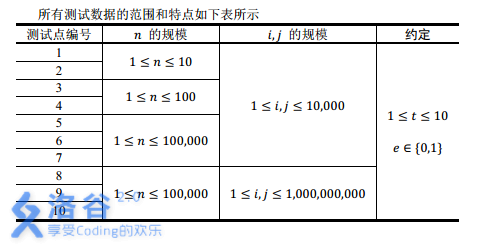
洛谷P1955 《[NOI2015]程序自动分析》
第一道NOI的题目
洛谷 P1955 题解
题目描述
在实现程序自动分析的过程中,常常需要判定一些约束条件是否能被同时满足。
考虑一个约束满足问题的简化版本:假设x1,x2,x3…代表程序中出现的变量,给定n个形如xi=xj或xi≠xj的变量相等/不等的约束条件,请判定是否可以分别为每一个变量赋予恰当的值,使得上述所有约束条件同时被满足。例如,一个问题中的约束条件为:x1=x2,x2=x3,x3=x4,x4≠x1,这些约束条件显然是不可能同时被满足的,因此这个问题应判定为不可被满足。
现在给出一些约束满足问题,请分别对它们进行判定。
输入输出格式
输入格式:
从文件prog.in中读入数据。
输入文件的第1行包含1个正整数t,表示需要判定的问题个数。注意这些问题之间是相互独立的。
对于每个问题,包含若干行:
第1行包含1个正整数n,表示该问题中需要被满足的约束条件个数。接下来n行,每行包括3个整数i,j,e,描述1个相等/不等的约束条件,相邻整数之间用单个空格隔开。若e=1,则该约束条件为xi=xj;若e=0,则该约束条件为xi≠xj;
输出格式:
输出到文件 prog.out 中。
输出文件包括t行。
输出文件的第 k行输出一个字符串“ YES” 或者“ NO”(不包含引号,字母全部大写),“ YES” 表示输入中的第k个问题判定为可以被满足,“ NO” 表示不可被满足。
输入输出样例
输入 #1
1 | |
输出 #1
1 | |
输入 #2
1 | |
输出 #2
1 | |
数据范围(图片来自洛谷)
解题思路
把题目中的「x1=x2」看做x1和x2在同一个集合里,「x1≠x2」看做x1和x2不在同一个集合里……
好了,显而易见这是道并查集的题目
读懂了题目,下手就很简单了
这里要注意:
「x1≠x2」是无法进行的操作(因为你不能强制他们不在同一个集合里!若非要实现,就又要维护一个数组),把它看成查询操作。
而且「x1=x2」类似的操作要先做,「x1≠x2」类似的操作要最后做(因为后者对集合没有影响,它是一个查询操作)
1 | |
代码实现
1 | |
离散化
简介
1 | |
对一堆数据进行离散化,
- 先排序 [ 推荐 std::sort() ](针对有序序列进行离散化)
- 删除重复元素(节省空间)
- 对数据进行索引(最终目的)
而其中我们要用到STL提供的pair来储存变量。pair提供一个包含两个数据成员的结构体模板,可以快速访问其中的元素,就像一个压缩包一样(
代码实现
1 | |
- 本文作者:Handwer STD
- 本文链接:https://blog.handwer-std.top/2018-05-12/Luogu-P1955/index.html
- 版权声明:本博客所有文章均采用 BY-NC-SA 许可协议,转载请注明出处!